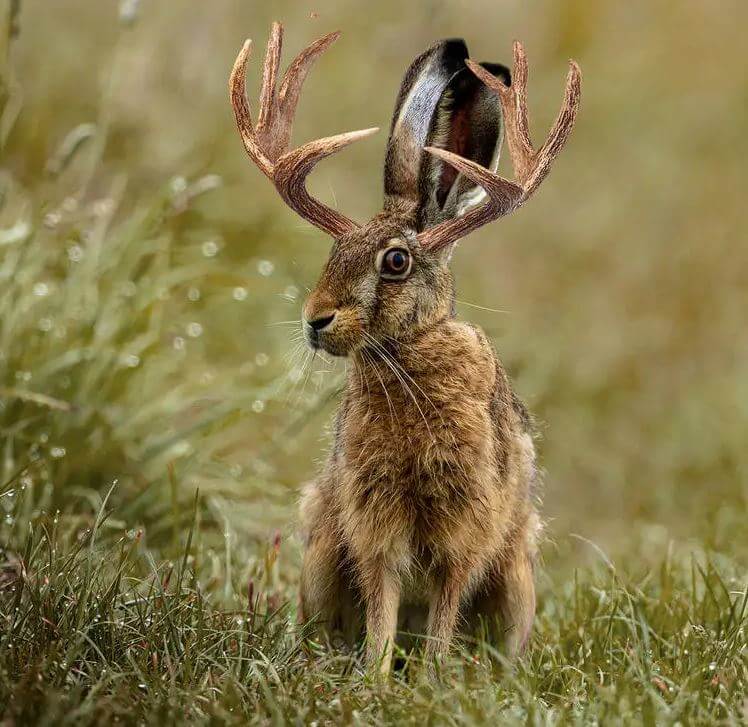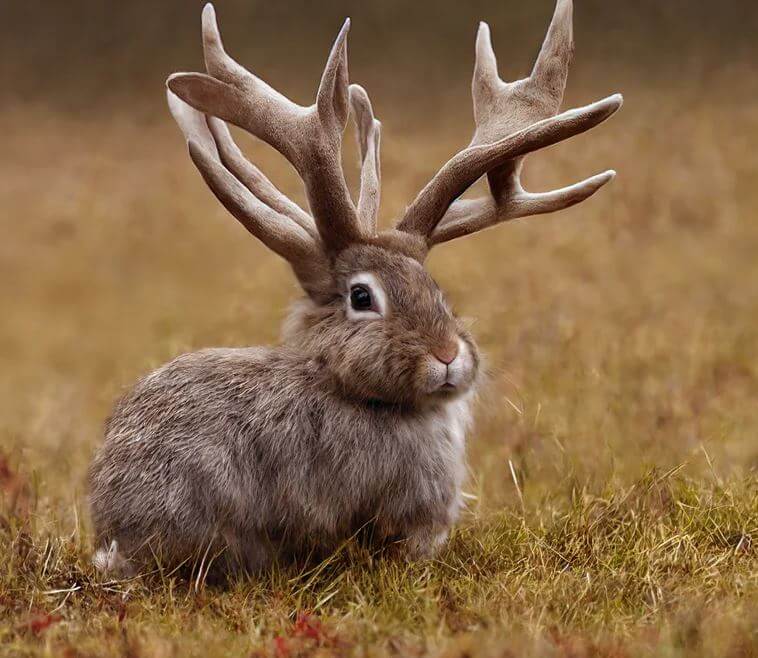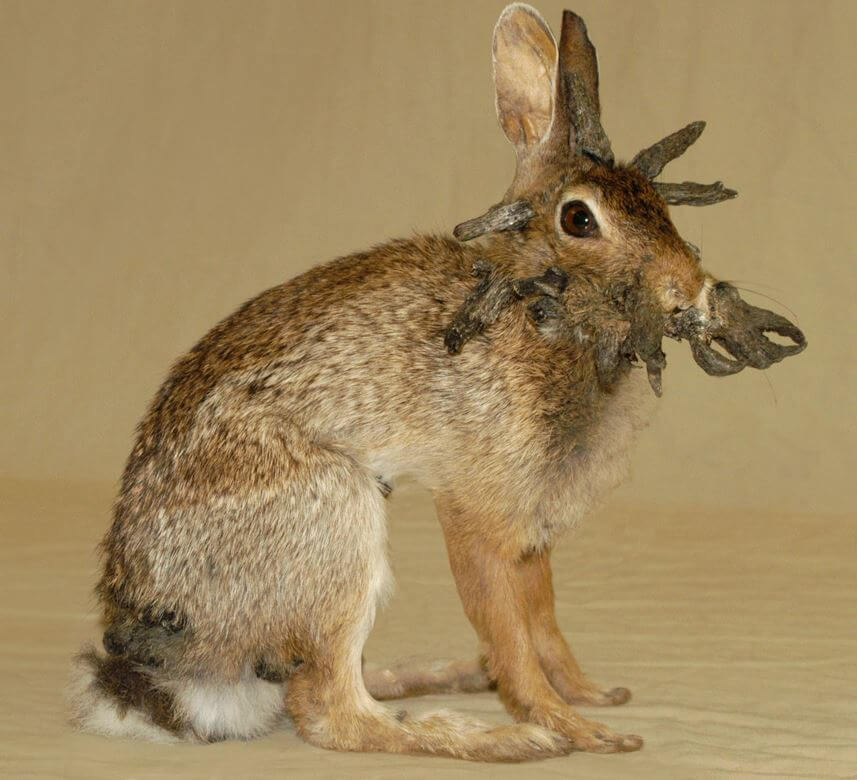Contents
Introduction to the Jackalope
What Is a Jackalope?

The Jackalope is a legendary creature that looks like a rabbit with the antlers of a deer or antelope. It’s one of those mythical animals that instantly sparks curiosity—partly because it’s both bizarre and oddly believable. The name “Jackalope” comes from combining “jackrabbit” and “antelope,” though in reality, antelope don’t live in the same regions as the supposed Jackalope. Descriptions vary slightly, but most agree the Jackalope is about the size of a large hare, with long ears, powerful legs, and an impressive rack of antlers.
In American folklore, the Jackalope isn’t just a visual oddity; it’s also credited with human-like abilities. Some tales claim it can mimic human voices, singing cowboy songs at night or responding to campfire conversations. Others suggest the Jackalope is cunning, swift, and almost impossible to capture. It’s often portrayed as a creature that thrives in the wide-open prairies, using its speed and antlers to evade hunters.
While skeptics dismiss it as a taxidermy hoax or a product of creative storytelling, the Jackalope has secured a spot in the pantheon of mythical creatures alongside Bigfoot, the Loch Ness Monster, and the Chupacabra.
The Origin of the Jackalope Myth
The story of the Jackalope is deeply tied to the culture of the American West, especially Wyoming, where it’s practically an unofficial mascot. One popular account credits its creation to Douglas Herrick and his brother in the 1930s. The Herricks were hunters and amateur taxidermists who allegedly mounted antelope horns onto a jackrabbit carcass as a joke. The result looked startlingly real, and soon, the mounted Jackalope heads began selling as novelty souvenirs.
But the concept itself may go back much further. Folklorists point out that horned rabbits appear in European art as early as the Middle Ages. These depictions likely influenced American settlers, who merged the imagery with the wildlife they encountered. The Old West was fertile ground for tall tales, and the Jackalope became a perfect fit—blending humor, exaggeration, and just enough plausibility to make people wonder.
Whether born from a hunting prank or centuries-old legend, the Jackalope’s story spread rapidly, cementing its place in roadside culture and regional pride.
Historical and Cultural Background
Folklore Roots in the American West
The Jackalope found its fame in the dusty towns and open plains of the American West, where storytelling was as much a pastime as a necessity. Cowboys, ranchers, and travelers often passed the time swapping tall tales around the campfire, and the Jackalope was a perfect subject.
This part of America was already rich with folklore—stories of ghost towns, buried treasure, and mysterious lights on the horizon. The Jackalope’s supposed ability to outwit hunters or mimic human voices fit neatly into this tradition. It also served as a point of regional identity, especially in Wyoming, where locals embraced the legend as a quirky badge of honor.
In some communities, fake hunting licenses for Jackalopes became a humorous tradition. These licenses often came with tongue-in-cheek rules, like only hunting between midnight and 2 a.m., or requiring hunters to wear “antler-proof” vests.
Influence of European Mythical Creatures
Long before the Jackalope appeared in American folklore, European cultures told stories of horned rabbits. The “wolpertinger” in Bavaria, the “rasselbock” in German folklore, and other similar creatures share striking similarities. These mythical hybrids were often portrayed as rare and elusive, blending traits of multiple animals.
It’s likely that immigrants brought these stories with them when they settled in the United States. Upon encountering jackrabbits in the wild, it wouldn’t have been much of a stretch for their imaginations to add antlers, creating a homegrown version of the old myths. The Jackalope’s American incarnation, however, had its own rugged, frontier flavor—less forest mystique, more desert grit.
How the Jackalope Became a Pop Culture Icon
By the mid-20th century, the Jackalope had hopped well beyond the borders of Wyoming. Roadside gift shops across the West sold Jackalope postcards, T-shirts, and mounted heads. Cartoons and TV shows began referencing the creature, further cementing its place in pop culture.
In many ways, the Jackalope became a symbol of playful Americana. It represented a blend of humor, creativity, and the storytelling spirit of the frontier. Even today, you can find entire festivals dedicated to the Jackalope, featuring costume contests, art displays, and “Jackalope calls” competitions.
The creature also made its way into advertising, video games, and even city branding. For example, Douglas, Wyoming, claims to be the “Jackalope Capital of the World” and uses the animal’s image in everything from street signs to tourism brochures.
Physical Description and Characteristics

Unique Physical Features
The Jackalope’s appearance is perhaps its most captivating trait—a perfect blend of familiar and fantastical. Imagine a jackrabbit, already a nimble and alert creature, with the regal antlers of a deer or antelope sprouting from its head. This striking combination is what makes people stop, stare, and ask, “Could it actually exist?”
Legends often describe the Jackalope as having larger-than-average ears and eyes, making it especially alert to danger. Its fur is typically depicted as mottled brown or gray, providing camouflage against the dry grasses and rocky terrain of the western plains. The antlers, depending on the tale, range from small prongs to full, branching racks worthy of a trophy deer.
Some versions of the legend even exaggerate its features to comical extremes—massive antlers that seem impossible for a rabbit to carry, or glowing eyes that pierce the night. These embellishments only enhance the Jackalope’s mythical charm. Whether seen as a whimsical creation or a possible cryptid, its unusual look is what makes it so unforgettable.
Behavioral Traits Attributed to the Jackalope
In folklore, the Jackalope isn’t just a static mount on a wall—it’s alive, clever, and elusive. One of its most famous abilities is mimicry. Cowboys told tales of hearing the Jackalope sing along with them as they strummed their guitars under the stars. Others claimed the creature could perfectly imitate a human voice, luring unsuspecting travelers into the dark.
The Jackalope is also said to be fiercely territorial. It allegedly uses its antlers for self-defense, charging at intruders with surprising force. Some hunters claim that even approaching one is risky—stories tell of sharp kicks and swift bites from these spirited creatures.
Another persistent belief is that Jackalopes are incredibly fast. They supposedly dart through the plains at lightning speed, making capture nearly impossible. Combined with their sharp wits and keen senses, it’s no wonder the Jackalope is considered one of the hardest “game animals” to hunt—if it exists at all.
Alleged Habitat and Range
The Jackalope’s mythical home is the open prairies and sagebrush-covered hills of the American West, especially Wyoming, South Dakota, and Nebraska. Folklore places them in regions with wide, open spaces where they can spot predators from afar and run at full speed without obstruction.
Some versions of the tale suggest they favor rocky outcroppings or abandoned prairie dog towns for shelter. Others claim they migrate seasonally, following the availability of food such as grasses, herbs, and wildflowers. In winter, they’re said to be even more elusive, blending perfectly with snow-covered landscapes.
While modern sightings are typically tongue-in-cheek tourist attractions, the legend’s geography is consistent—Jackalopes are creatures of the West. This association is so strong that even towns outside Wyoming sometimes adopt the creature as a fun regional mascot, keeping the myth alive for new generations.
The Science Behind the Legend

Possible Real-Life Inspiration – Shope Papillomavirus in Rabbits
While the Jackalope may be a work of folklore, some scientists suggest it might have roots in real biological phenomena. Shope papillomavirus, a disease affecting rabbits, causes horn-like growths on their heads and faces. To an untrained eye—or a storyteller’s imagination—this could easily resemble antlers.
Discovered in the 1930s by Dr. Richard Shope, the virus creates keratinized tumors that can grow quite large. Infected rabbits may develop multiple horn-like projections, which explains how early settlers might have mistaken them for a strange hybrid species.
Though the disease is unfortunate for the animals it affects, it provides an intriguing scientific angle to the Jackalope legend. It’s a reminder that many myths are born from real-life observations, then shaped into fantastic stories through the lens of human creativity.
Taxidermy and Tourist Souvenirs
Another major driver of the Jackalope’s fame is taxidermy. The Herrick brothers of Douglas, Wyoming, made their first Jackalope mount in the 1930s, and soon after, the idea caught on across the region. Taxidermists would attach deer antlers to rabbit bodies, creating realistic-looking hybrids that could fool the casual observer.
These mounts became popular roadside curiosities. Travelers passing through small towns could pick up a Jackalope head for their wall, a photo postcard, or even a faux hunting license. Shops leaned into the humor, selling “Jackalope milk” and telling tourists that the animals could only be milked while sleeping.
This playful commercialization cemented the Jackalope’s place in American kitsch. Even today, some souvenir stores keep the tradition alive, selling Jackalope mounts to delighted visitors who know they’re in on the joke.
Why People Still Believe in the Jackalope
Despite its clear status as folklore, the Jackalope continues to have believers—or at least people who want to believe. Part of the allure is that it’s a “friendly” cryptid. Unlike Bigfoot or the Mothman, the Jackalope isn’t menacing. It’s whimsical, approachable, and tied to the romance of the Old West.
There’s also the simple fact that myths endure because they’re fun. Parents pass the story down to children, towns host Jackalope festivals, and artists keep reimagining the creature in new ways. It’s less about proving the Jackalope’s existence and more about keeping the spirit of storytelling alive.
In a world where much of nature has been cataloged and explained, the Jackalope offers a rare space for imagination to run free. And sometimes, that’s all people need to keep a legend alive.
The Jackalope in Popular Culture and Media
Jackalope Appearances in Movies and TV Shows
The Jackalope has made plenty of cameos in pop culture over the years, often used as a humorous or whimsical reference. One of the most famous appearances was in the 1990s children’s program America’s Funniest People, where a puppet Jackalope delivered rapid-fire jokes with the catchphrase, “Fast as fast can be, you’ll never catch me!”
It’s also popped up in animated shows, films, and even commercials, usually as a nod to quirky Americana. These portrayals often lean into the playful side of the legend, showing the Jackalope as mischievous but ultimately harmless.
In more niche media, the Jackalope appears in fantasy novels, role-playing games, and indie video games, where it’s sometimes given magical powers or special significance as a rare creature. Its adaptability as a symbol makes it a perfect fit for various creative interpretations.
Representation in Art and Literature
Artists and writers have long been drawn to the Jackalope, not just for its strange beauty but for the layers of meaning it can carry. In visual art, it’s often portrayed with a touch of whimsy—rabbits with antlers leaping across prairie landscapes or resting regally under moonlight. Painters and illustrators play with size and proportion, sometimes exaggerating the antlers to comical extremes, sometimes rendering them so realistically that they could pass for genuine wildlife portraits.
In literature, the Jackalope serves many purposes. In children’s books, it might be a friendly guide or a clever trickster helping protagonists learn lessons about courage or curiosity. In adult fiction, it can represent the blending of myth and reality, a metaphor for the human tendency to believe in the extraordinary. Writers also use it as a symbol of the American frontier spirit—wild, unpredictable, and full of tall tales waiting to be told.
Folklorists and ethnographers have even dedicated chapters to the Jackalope in studies of American mythmaking. These analyses often place the creature alongside other hybrid or impossible animals from global traditions, showing that the human love for mixing the real with the imaginary is universal.
Merchandise, Festivals, and Tourism
If you’ve ever road-tripped through the American West, chances are you’ve seen a Jackalope staring down at you from a gift shop shelf. Its presence in merchandise is one of the biggest reasons the legend has survived for decades.
Popular merchandise includes:
-
Mounted Jackalope heads (taxidermy or plush versions)
-
T-shirts, mugs, and keychains featuring Jackalope art
-
Faux “hunting licenses” with humorous restrictions
-
Postcards depicting the creature in its natural “habitat”
Towns like Douglas, Wyoming, take things a step further by hosting Jackalope Days, complete with costume contests, music, food stalls, and children’s activities. Visitors can pose with oversized Jackalope statues, participate in storytelling sessions, and join mock “Jackalope hunts” that are more about fun than finding anything real.
Tourism boards have cleverly leaned into the creature’s notoriety, using it to draw in visitors who might otherwise just pass through. In this way, the Jackalope has transformed from a dusty roadside curiosity into an economic asset—a prime example of folklore fueling local pride and business.
Conclusion
The Jackalope might not roam the prairies in reality, but it lives on in the collective imagination. Born from a mix of frontier storytelling, European myths, and clever taxidermy, it has hopped its way into art, media, and tourism. More than just a funny roadside attraction, it represents the enduring human love for a good story—especially one that straddles the line between the believable and the impossible.
In the end, whether you see the Jackalope as a symbol of Americana, a quirky cryptid, or just a brilliant piece of folk humor, one thing is certain: it’s proof that some legends are too charming to ever truly fade away.
FAQs
1. Is the Jackalope real?
No scientific evidence supports the existence of the Jackalope, though some aspects of the legend may be inspired by rabbits affected by Shope papillomavirus.
2. Where did the Jackalope originate?
The modern legend began in Wyoming in the 1930s, though horned rabbit myths date back to medieval Europe.
3. Can you buy a Jackalope mount?
Yes—many tourist shops in the American West sell taxidermy or novelty versions of Jackalope heads.
4. What makes the Jackalope special in folklore?
It’s a playful mix of reality and imagination, blending a familiar animal with an unexpected twist.
5. Why is Wyoming known for the Jackalope?
The Herrick brothers, who popularized Jackalope taxidermy, were from Douglas, Wyoming, which now calls itself the “Jackalope Capital of the World.”
